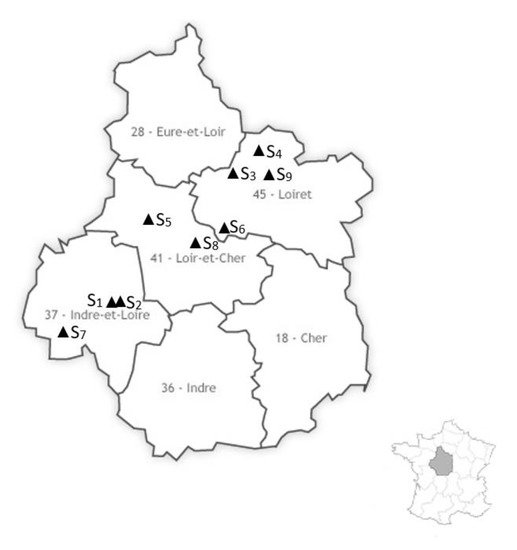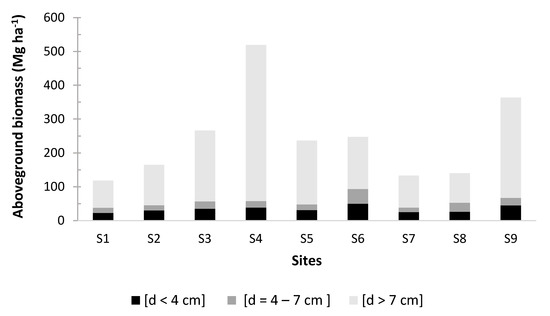You're using an outdated browser. Please upgrade to a modern browser for the best experience.
Please note this is an old version of this entry, which may differ significantly from the current revision.
Subjects:
Forestry
Forest biomass is a sustainable source of renewable energy and a valuable alternative to finite fossil fuels. However, its overharvesting may lead to soil nutrient depletion and threaten future stand productivity, as well as affect the habitat for biodiversity.
- whole-tree harvesting
- biomass
- fuelwood
- fine woody debris
- coarse woody debris
1. Introduction
The European Union is resolved to reduce greenhouse gas emissions and promoting the development of new energy policies to reverse the trend of global warming associated with climate change [1,2]. These policies aim to develop new and sustainable energy sources and contribute to a reduction in the growing dependency of EU countries on fossil fuels. Amongst renewable resources, paramount importance has been given to the bioenergy because it has low negative environmental impacts. Biomass was one of humanity’s earliest sources of energy, and it remains an important resource today and for the future to enhance security energy. Today, biomass accounts more than half of all the EU’s renewable energy production and 10% of all energy sources [3]. This figure is likely to rise in the future because it is considered a promising alternative to fossil energy in order to shift towards sustainability. Woody biomass accounts for more than 60% of all EU domestic biomass [4]. Indeed, fuelwood seems to be a promising option in temperate forests and developed countries [5] by providing a local supply of renewable energy and by allowing forest owners to diversify their sources of income [6]. In most European countries, woody biomass demand is rising fast with many bioenergy strategies [7,8], which have led to the adoption of new logging practices [9,10,11]. Different biomass harvesting methods are used in Europe; their selection depends on site conditions, silvicultural treatments, species composition, tree sizes, stand density, and the economic condition of each country. The main types of silvicultural operations, related to forest biomass extraction, are whole-tree harvesting in cleaning, thinning, and harvesting of woody debris and stumps before regeneration [12]. Nevertheless, the intensive harvesting of biomass for energy may cause additional pressure on forested ecosystems [13,14,15,16,17,18,19]. Recent interest in using woody debris and small-diameter material for biofuels is generating a renewed focus for studies on harvesting impacts on soils, biodiversity, and forestry practice sustainability. Indeed, this part of biomass, usually left in the forest in conventional harvesting systems, plays an essential role in nutrient cycles, maintenance of soil fertility, carbon sequestration, regeneration of communities, and biodiversity [9,10,17,20].
Forest residues, downed wood, and deadwood are different terms used to define woody debris, including all nonliving biomass. Woody debris refers to fallen dead trees and the remains of twigs, branches, and small pieces of wood left on the ground in forests. It is generally divided into two main classes: (1) Fine Woody Debris (FWD) with a diameter less than, or equal to, 10 cm, and (2) Coarse Woody Debris (CWD) greater than 10 cm in diameter [21,22]. However, as there are no clearly defined criteria to separate these two classes, the diameter limit may vary depending on the countries or research purposes. For example, the limit between the two classes is 7.6 cm (3 inches) in some studies conducted in the United States [23,24,25]. In addition, the number of wood diameter classes can also vary according to the objectives of the studies; three to five classes are often used to better estimate the nutrient contents of woody debris and the mineral exports associated with their removal [26,27,28].
Despite the relatively low proportion FWD compared to total harvested biomass, it contains a large amount of nutrients that are key elements for forest growth, and its overharvesting could compromise long-term forest site fertility [5,16,29,30]. Several studies have demonstrated that harvesting fine wood affects the soil nutrient cycling and thus future site productivity, even with high rates of fertilizer application [18,31,32,33]. CWD is also an important component of forest ecosystems in that it provides habitats or micro-habitats, for saproxylic species, trophic substrate, soil texturing and structuring, and temporary carbon stock [10,20].
Studies in European forests have shown that there is a significant correlation between woody debris volume, harvest methods, and such forest parameters as management, site or stand attributes [34,35]. To prevent any reduction in the woody debris left in forests and negative effects of whole-tree harvesting, many countries have established guidelines for sustainable harvesting of forest biomass in order to limit nutrient exports mainly contained in leaves and fine wood [19,28,36,37]. The guidelines are generally based on volumes or on the number of wood pieces that should be left on the forest. However, the existing recommendations for sustainable biomass harvesting may vary between countries. For instance, Nordic countries and the United Kingdom first classify sites and stands according to their sensitivity to biomass extraction (forest type, soil fertility, wood production, soil compaction, and slope), and different restrictions are then imposed for the specific site types [38,39]. For example, Finnish guidelines recommend leaving up to 30% of woody debris, or the same amount of nutrients, on the forest floor [40], using ash recycling or fertilization [12,41]. In France, the recommendations for sustainable biomass harvesting have continuously been updated since 2006 [42] through several scientific studies and increasing technical expertise [28,36,42]. The latest recommendations take into account local conditions, in particular soil sensitivity to mineral exports [28]. It is highly recommended to leave at least 10% of fine wood with a diameter of less than, or equal to, 7 cm on the forest floor for non-sensitive soils, and to increase this value to 30% on moderately sensitive soils. In the case of highly sensitive or poor soils, harvesting fine wood is not recommended; all fine wood should be left on the forest floor. Furthermore, according to USDA guidelines for the Pacific North West, at least 4%–5% of total forest biomass should be retained on the operation site to avoid soil degradation and growth decline in the next rotation [37].
Overall, the national guidelines cover the same topics and often make similar general recommendations. To protect sensitive soils, most guidelines recommend restricting biomass removal on sites identified as sensitive; site sensitivity is often based on a combination of indicators, such as slope, soil depth, and soil moisture regime, all of which may be related to susceptibility to erosion, compaction, loss of fertility, and ecosystem resilience to harvesting. To protect biodiversity, most guidelines advise for example retaining at least 10 to 30% of the slash or tops, retaining biological legacies, such as large logs, snags, or wildlife trees, and restricting biomass harvesting near critical habitats and retaining appropriate vegetation and deadwood for habitats or along rivers [37,43,44]. On top of that, it is highly recommended to harvest during the leafless period to avoid exporting leaves from forests. However, when harvesting takes place within the leafed period on evergreen species, extracting crown biomass is recommended only after pre-drying operation [12,28,42]. Pre-drying felled trees is carried out on the forest before skidding operations. This operation has two major roles: first, it may allow the weakened leaves, twigs, and fine wood to fall off during the skidding. Second, it allows maintaining a certain amount of nutrients by leaching via rainfall, depending on weather conditions.
2. Study Area
The study area is located in the Centre-Val de Loire region, Central France (Lat 47.705141°; Long 1.647949°). Forests are mainly private (87%), composed of broadleaves species and cover a quarter of its total area [45]. They contain an important fuelwood resource but their soils are nutrient-poor and sensitive to the loss of fertility [46]. Half of the forested area of the region has long been managed in a coppice-with-standards (CWS) regime [47]. The standard layer is mostly dominated by deciduous oaks (Quercus robur L., Q. petraea (Matt.)) Liebl. and in the coppice layer by hornbeam (Carpinus betulus L.), sweet chestnut (Castanea sativa Mill.) and other deciduous species.
Nine whole-tree harvesting sites in central France were sampled for three years 2017–2020 (Figure 1). Three sites are located in a public forest, and five are in different private forests. Some of the sites are located in protected areas of the Natura 2000 network, but none are concerned by a high-level protection measures.

Figure 1. Location of the nine studied sites (S1 to S9) on the map of the Centre-Val de Loire region that comprises six departments: Cher (18), Eure-et-Loir (28), Indre (36), Indre-et-Loire (37), Loir-et-Cher (41), Loiret (45).
3. Aboveground Biomass and Harvest Intensity
The studied sites correspond to different stand structures, species composition, and management systems. Aboveground biomass estimates (Figure 3) showed a high variability between sites: standing biomass varied between 118 and 519 Mg ha−1. In contrast, less variability was found between sites managed as coppice and CWS (S1, S2, S5, S6, S7, and S8), the mean aboveground biomass was amounted to 174 ± 56 Mg ha−1. High forest sites (S3, S4, and S9) contain obviously more biomass 383 ± 127 Mg ha−1. The proportion of wood [d > 7 cm] in total biomass was greater in high forests (83 ± 5%) than in other stands (69 ± 7%). In contrast, the percentage of wood [d ≤ 7 cm] was lower in high forests 17 ± 5% compared to CWS sites 31 ± 7%.

Figure 3. Estimates of standing biomass on the nine sites before harvest by diameter classes.
In general, the harvest intensity was highly variable and ranged between 13% and 100% (Table 2). On sites managed as coppice and CWS, more than 70% of aboveground biomass was harvested (S2, S6, S7, and S8), 43% for S5 and 33% for S1. However, the harvest intensity was lower in high forests (S3, S4, S9) and ranged between 13% and 52%.
Table 2. Amounts (Mg ha−1) and proportions (%) of woody debris left on sites presented for each wood diameter class.
| Sites | Harvest Intensity (%) | FWD | CWD | Total Woody Debris | Total Woody Debris | ||||||
|---|---|---|---|---|---|---|---|---|---|---|---|
| [d ≤ 4 cm] | [d = 4–7 cm] | Total [d ≤ 7 cm] | [d > 7 cm] | Harvested Biomass | |||||||
| Mg ha−1 | % | Mg ha−1 | % | Mg ha−1 | % | Mg ha−1 | % | Mg ha−1 | % | ||
| S1 | 33 | 9.33 | 70 | 0.42 | 4 | 9.75 | 39 | 0 | 0 | 9.75 | 25 |
| S2 | 72 | 4.17 | 17 | 0.95 | 8 | 5.12 | 14 | 0.15 | 0 | 5.27 | 4 |
| S3 | 52 | 2.38 | 9 | 0.56 | 3 | 2.94 | 7 | 0.77 | 1 | 3.71 | 3 |
| S4 | 13 | 0.67 | 6 | 0.25 | 3 | 0.92 | 4 | 4.88 | 10 | 5.80 | 9 |
| S5 | 43 | 2.37 | 11 | 0 | 0 | 2.37 | 7 | 4.31 | 6 | 6.68 | 7 |
| S6 | 75 | 3.97 | 10 | 0 | 0 | 3.97 | 5 | 6.32 | 6 | 10.29 | 6 |
| S7 | 100 | 12.47 | 49 | 0.74 | 6 | 13.21 | 34 | 0 | 0 | 13.21 | 10 |
| S8 | 81 | 3.73 | 16 | 0.78 | 3 | 4.51 | 9 | 1.33 | 2 | 5.84 | 5 |
| S9 | 35 | 1.70 | 7 | 0 | 0 | 1.70 | 4 | 1.99 | 2 | 3.69 | 3 |
This entry is adapted from the peer-reviewed paper 10.3390/f12060807
This entry is offline, you can click here to edit this entry!
